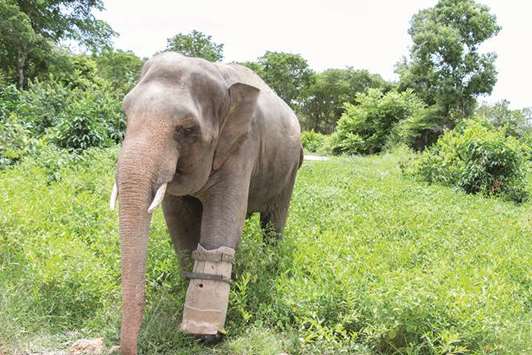Lucky, an 18-year-old Asian elephant, trudges along a lightly wooded path on an early weekday morning, accompanied by her trainer and half a dozen foreign tourists a few steps behind.
The walk is part of Lucky’s daily routine. And so is interacting with visitors, who have paid 150 dollars for a behind-the-scenes tour of Phnom Tamao Wildlife Rescue Centre.
Just an hour’s drive from Phnom Penh, the centre is run by the Cambodian government with assistance from the environmental group Wildlife Alliance. For a premium price, tourists can get up-close access to animals like Lucky. After the morning walk, these tourists get to hand-feed the elephant pineapples and watermelon.
Lucky is an amenable host, having lived with humans for most of her life after being rescued from traffickers in 1999 as a baby.
Equipped with similar emotions to a human child, she imprinted on her trainer at the sanctuary, according to tour guide Nikki Sullivan, which has made her incapable of returning to the wild because she is too comfortable with humans.
Lucky is just one of the centre’s 1,200 permanent residents, which also include endangered species like tigers, sun bears, gibbons and leopards.
The centre also accepts ordinary animals like macaque monkeys, which often arrive after having been earlier raised as pets.
Most of the permanent residents are either physically or psychologically damaged, like Lucky and her fellow elephant, 12-year-old Chhouk.
Chhouk has a prosthetic leg after being caught in a hunter’s snare, and emotional wounds from being abandoned by his herd.
But the sanctuary’s main mission is rehabilitating the 300 to 400 animals – often endangered species – that come through its doors each month.
Many end up at Phnom Tamao due to lost habitat or after being seized from traffickers by Wildlife Alliance’s Rapid Rescue Team, which includes police officers, Forestry Administration officials and civilians with the authority to arrest traders and confiscate animals.
After a stint at Phnom Tamao, many animals are later released at one of three protected sites regularly monitored by the organisation.
While Cambodia is not a major consumer of endangered wildlife, it is a hotspot for the trade due to its high biodiversity and central location, says Emma Pollard, who manages Wildlife Alliance’s rescued wildlife care.
“Cambodia is a transit country, so a lot of products come from Thailand through Cambodia or Laos to get up to Vietnam and China,” says Pollard.
Demand is high in Vietnam and China for endangered or exotic species, and animal protection laws there are limited, she adds.
Vietnam alone consumes or trades 3,700-4,500 tons of wildlife products annually, according to the World Wildlife Fund (WWF).
China has a well-known appetite for products like African elephant ivory, bear bile, tiger parts and the scales and meat of Cambodia’s endangered pangolins – often dubbed the “world’s most hunted animal” – for its supposed effects on virility.
Wildlife Alliance, the World Wildlife Fund (WWF) and other animal protection groups are up against large trafficking syndicates and an industry worth 19 billion dollars a year.
Many of these animals are destined to be used as “traditional medicine,” mainly in China and Vietnam, although the industry is evolving as both countries become increasingly wealthy.
“We’ve heard the trade is decreasing for traditional medicine but unfortunately the trade in status symbols is increasing,” Pollard says. “Nothing says status, power or money like an endangered species.”
The tour brings visitors up close and personal with animals they may only have read about in the news. Backstage access allows visitors to observe Phnom Tamao’s three hybrid male tigers in their “dens,” and a close-up view of the animals’ gaunt frames and other health problems, which are side-effects of inbreeding in captivity for traffickers.
Visitors also get to see the world’s largest sun bear sanctuary, along with Phnom Tamao’s resident leopards and seemingly endless supply of gibbons and macaque monkeys.
One of the most memorable stops, though, is at the “nursery” towards the end of the day, says Australian tourist Andrew Fitzgerald, who visited Phnom Tamao at the end of April.
“Being lucky enough to catch a [baby] pangolin sighting would have to be the highlight. We were lucky enough to go when there was one in the nursery, which is open to people on tour there,” he said.
“More than that, he took our arrival as a cue to start exploring his new enclosure, so that was pretty cool.” -DPA

Chhouk, a permanent resident of Phnom Tamao Wildlife Rescue Centre, walks with his prosthetic leg which was removed after he was caught in a hunter’s snare as a baby.


